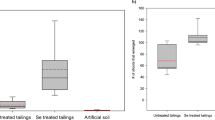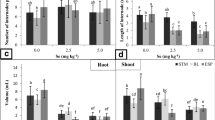Abstract
Disposal of saline irrigation wastewater in hydrologically closed sinks in the semi-arid western U.S. has concentrated selenium-rich salts to hazardous levels and phytoextraction, along with plant-enhanced volatilization of methyl-selenides, is an active area of research. Here, we provide an overview of our ongoing studies of Stanleya pinnata (Brassicaceae), a previously unstudied candidate that is a primary accumulator (hyperaccumulator) of Se that is widespread and broadly adapted in the western U.S. When grown in sand culture under uniform greenhouse conditions, 16 populations representing S. pinnata's broad biogeographical range differed in shoot Se concentration by 1.4- to 3.6-fold, and the shoot concentrations were positively correlated with the indigenous soil Se levels at the collection sites. Thus, S. pinnata exhibits significant ecotypic variation in Se accumulation. All populations accumulated SeO4 2- preferentially over SO4 2- consistent with S. pinnata's classification as a primary Se accumulator, while hydroponically-grown Brassica juncea consistently accumulated sulfate preferentially over selenate. The Se in S. pinnata shoots was predominately in the soluble amino-acid pool, which may serve as direct precursor to volatile forms such as dimethyldiselenide; inorganic forms (e.g. selenate) dominated in B. juncea. Preliminary results suggest that S. pinnata may volatilize unusually large quantities of Se when grown at high sulfate concentrations, an unexpected result not heretofore reported in any species. In a sand–culture experiment, S. pinnata exhibited excellent tolerance of excess boron, but only moderate tolerance of salinity, and superior genotypes will likely be needed for phytoremediation of highly salinized soils and sediments. Stanleya pinnata is a perennial that responded favorably to repeated cuffing in the greenhouse, a trait that could prove valuable in field-scale phytoremediation. Environmental concerns about Se are common in the western USA, and S. pinnata is a potentially useful species for phytoremediation due to its broad adaptation to western soils and environments, and its uptake, metabolism and volatilization of Se.
Similar content being viewed by others
References
Banuelos G S Meek D W and Hoffman G J 1990 The influence of selenium, salinity. boron on selenium uptake in wild mustard. Plant Soil 127, 201–206.
Banuelos G S, Ajwa H A, Mackey M, Wu L, Cook C, Akohoue S and Zambruzuski S 1997a Evaluation of different plant species used for phytoremediation of high soil selenium Environ. Qual. 26, 639–646.
Banuelos G S, Ajwa H A, Terry N and Zayed A 1997b Phytoremediation of seleni laden soils: a new technology. J. Soil Water Conserv. 52, 426–430
Bell P F, Parker D R and Page A L 1992 Contrasting selenate-sulfate interactions selenium– accumulating and nonaccumulating plant species. Soil Sci. Soc. Am. J. 56, 1818–1824.
Brown T A and Shrift A 1982 Selenium: toxicity and tolerance in higher plants. Biol. Re 57, 59–84.
de Souza M P, Lytle M, Mulholland M M, Otte M L and Terry N 2000 Selenium assimilation and volatilization from dimethylselenoniopropionate by Indian mustard. Plant Physiol. 122, 1281–1288
Evans C, Asher C J and Johnson C M 1968 Isolation of dimethyl diselenide and other volatile selenium compounds from Astragalus racemosus (Pursh.). Austr. J. Biol. Sci. 21, 13–20.
Feist L J and Parker D R 2001 Ecotypic variation in selenium accumulation among populations of Stanleya pinnata. New Phytol. 149, 61–69.
Läuchli A 1993 Selenium in plants: uptake, functions, and environmental toxicity. Bot. Acta 106, 455–468.
Lewis B G, Johnson C M and Delwiche C C 1966 Release of volatile selenium compounds by plants. Collection procedures and preliminary observations. J. Agr. Food Chem. 14, 638–640.
Neuhierl B and Bock A 1996 On the mechanism of selenium tolerance in selenium-accumulating plants. Purification and characterization of a specific selenocysteine methyltransferase from cultured cells of Astragalus bisculatus. Eur. J. Biochem. 239, 235–238.
Parker D R and Page A L 1994 Vegetation, management strategies for remediation of selenium– contaminated soils. Selenium in the Environment. In W T Frankenberger Jr and S Benson Ed. pp. 327–341. Dekker, New York.
Parker D R, Page A L and Thomason D N 1991 Salinity and boron tolerances of candidate plants for the removal of selenium from soils. J. Environ. Qual. 20, 157–163.
Pilon– Smits E A H, Hwang S, Lytle C M, Zhu Y, Tai J C, Rogelio C B, Chen Y, Leustek T and Terry N 1999 Overexpression of ATP Sulfurylase in Indian mustard leads to increased selenate uptake, reduction and tolerance. Plant Physiol. 199, 123–132.
Retana J, Parker D R, Amrhein C and Page A L 1993 Growth and trace element concentrations of five plant species growth in a highly saline soil. J. Environ. Qual. 22, 805–811.
Shrift, A 1969 Aspects of selenium metabolism in higher plants. Ann. Rev. Plant Physiol. 20, 475–494.
Terry N, Carlson C, Raab T K and Zayed A M 1992 Rates of selenium volatilization among crop species. J. Environ. Qual. 21, 341–344.
Terry N, Zayed A M, de Souza M P and Tarun A S 2000 Selenium in higher plants. Ann. Rev. Plant Physiol. Plant Molec. Biol. 51, 401–432.
Zayed A and Terry N 1994 Selenium volatilization in roots and shoots: effects of shoot removal and sulfate level. J. Plant Physiol. 160, 180–184.
Zhang Y and Frankenberger W T Jr 2001 Speciation of selenium in plant water extracts by ion exchange chromatography– hydride generation atomic absorption spectrophotometry. Sci. Total Environ. 269, 39–47.
Author information
Authors and Affiliations
Corresponding author
Rights and permissions
About this article
Cite this article
Parker, D.R., Feist, L.J., Varvel, T.W. et al. Selenium phytoremediation potential of Stanleya pinnata . Plant and Soil 249, 157–165 (2003). https://doi.org/10.1023/A:1022545629940
Issue Date:
DOI: https://doi.org/10.1023/A:1022545629940




